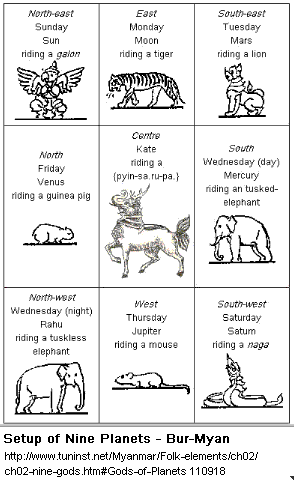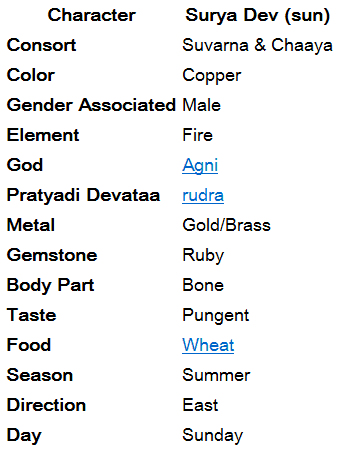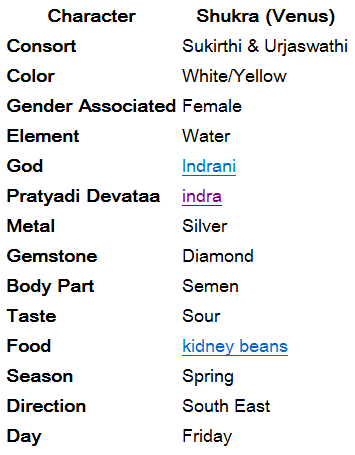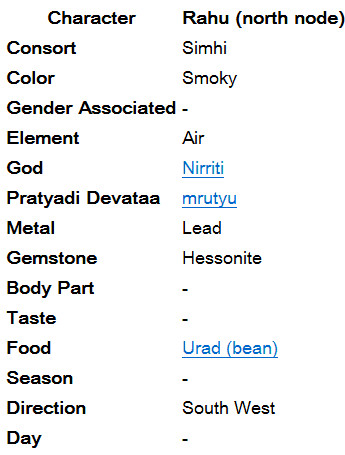na1la1-094b2-5.htm
from: Online Sanskrit Dictionary, February 12, 2003 . http://sanskritdocuments.org/dict/dictall.pdf 090907
Downloaded, set in HTML, and edited by U Kyaw Tun, M.S. (I.P.S.T., U.S.A.), and staff of TIL Computing and Language Centre, Yangon, Myanmar. Not for sale. No copyright. Free for everyone.
index.htm | Top
SED-con-r4-indx.htm
UKT notes
• Navagraha -
![]() {Bu.ra: ko:hsu} puja
{Bu.ra: ko:hsu} puja
• नलिनी (nalinii)
Skt: नलिनी
(nalinii) - lotus - OnlineSktDict
Pal: nalina n. a lotus flower - UPMT-PED118
Pal: {na.li.na.}
• नलिनीदलगत
(naliniidalagata)
Skt: नलिनीदलगत
(naliniidalagata) - nalinI + dala + gata, lotus + petal + reached/ gone - OnlineSktDict
• नवं (navaM)
Skt: नवं
(navaM) - a boat - OnlineSktDict
• नवकमलदल (navakamaladala)
¤ नवग्रह navagráha
Skt: नवग्रह navagráha -
nine seizers or nine influencers - Wiki
See my note on Navagraha
• नवद्वारे
(navadvaare)
Skt: नवद्वारे
(navadvaare) - in the place where there are nine gates - OnlineSktDict
• नवमि (navami)
Skt: नवमि (navami) - Ninth Tithi of the Moon - OnlineSktDict
• नववस्तु
(navavastu)
Skt: नववस्तु
(navavastu) - New article - OnlineSktDict
• नवांश (navaa.nsha)
Skt: नवांश
(navaa.nsha) - a varga. The 9th divisional harmonic - OnlineSktDict
Used with the rasi, chandra, and bhaavana charts to determine a basic delineation for reading the delineations of the spouse. - OnlineSktDict
• नवानि (navaani)
Skt: नवानि
(navaani) - new garments - OnlineSktDict
• नवीनम्
(naviinam.h)
Skt: नवीनम्
(naviinam.h) - adj. new - OnlineSktDict
• नवैः (navaiH)
Skt: नवैः
(navaiH) - instr. new - OnlineSktDict

UKT: Worship of the Nine Planets, Navagraha नवग्रह,
should be compared the Bur-Myan practice of
![]() {Bu.ra: ko:hsu} puja. Here, the Bur-Myan word
{Bu.ra: ko:hsu} puja. Here, the Bur-Myan word
![]() {Bu.ra:}
must not be translated as 'Buddha'. It simply means 'those who are fit to be
worshipped' - whether out of respect or fear. Thus the word
{Bu.ra:}
must not be translated as 'Buddha'. It simply means 'those who are fit to be
worshipped' - whether out of respect or fear. Thus the word
![]() {Bu.ra:}
includes 'kings' and 'queens' including the present day dictators.
{Bu.ra:}
includes 'kings' and 'queens' including the present day dictators.
See Dr. Htin Aung, Folk Elements in Burmese Buddhism, Printed and published by U Myint Maung, Deputy Director, Regd: No (02405/02527) at the Religious Affairs Dept. Press. Yegu, Kaba-Aye P.O., Rangoon, BURMA. 1981. http://www.tuninst.net/Myanmar/Folk-elements/ch02/ch02-nine-gods.htm 110918
Inset pix: the figures of animals, except the
![]() {piń~sa.ru-pa.} at the centre, are from Facets of Life at Shwedagon Pagoda
in Colorful Myanmar by Daw Khin Myo Chit.
{piń~sa.ru-pa.} at the centre, are from Facets of Life at Shwedagon Pagoda
in Colorful Myanmar by Daw Khin Myo Chit.
- UKT 110918
From Wikipedia: http://en.wikipedia.org/wiki/Navagraha 100427
Graha (ग्रह gráha — seizing, laying hold of, holding [1]) is a 'cosmic influencer' on the living beings of mother Bhumidevi (earth). In Hindu Astrology, the Navagraha ( नवग्रह, nine seizers or nine influencers) are some of these major influencers.
The term Graha has sometimes been mistranslated as "planet", as five of the Navagraha (the "nine grahas") happen to be planets: Mars, Mercury, Jupiter, Venus, and Saturn.[2] The sun, moon, Rahu (north or ascending lunar node) and Ketu (south or descending lunar node) are not "planets", however, and each of these nine entities are conceived only as chief celestial entities, constituting the Navagraha.[2] A fact common to all the navagraha is that they have relative movement with respect to the background of fixed stars in the zodiac.
"Graha" is sometimes also translated as "celestial body", but Rahu and Ketu are not celestial bodies, but only positions in the lunar path.[2] A third translation is celestial god or demi-god, but again, Rahu and Ketu are demonic Asuras, not benign deities like Devas.[2] Accordingly to some, Grahas are the "markers of influence" that point out the karmic influence on the behavior of living beings. They themselves are not causative elements[3] but can be compared to traffic signs.
According to the astrological treatise Prasna Marga, there are many other spiritual entities called grahas or spirits. All (except the navagrahas) are said to have been born of the anger of Lord Shiva or Rudra. Most grahas are generally malefic in nature but there are a few that may be good.[4] The book called The Puranic Encyclopedia, under the heading 'Graha Pinda', gives a list of such grahas (spirits or spiritual entities, etc), that are said to afflict children, etc. Also in the same book in various places the names of spirits (grahas) are given, like 'Skhanda graha' that is said to cause miscarriage(s).[5]
Astrologers claim that Grahas influence the auras (energy bodies) and minds of beings connected to the Earth. Each Graha carries a specific energy quality, which is described in an allegorical form through its scriptural and astrological references. The energies of the Grahas are getting connected in a specific way to the individual auras of humans at the time they take their first breath in a given nativity. These energy connections remain with the natives of Earth as long as their current body lives. "The nine planets are transmitters of universal, archetypal energy. The qualities of each planet help to maintain the overall balance of polarities in both the macrocosmic and the microcosmic universe - as above, so below..."[6]
Humans are also capable to tune themselves to the chosen energy of a specific Graha through Samyama with that Graha or its presiding deity. The effects of worship of specific deities are manifested accordingly to the layout of their relative energies in a given nativity of a worshiper in question, in particular depending on the Bhavas occupied by the respective Grahas.
The idea of planets, stars and other celestial bodies being the living energy entities influencing the other beings of the Universe has cross-references in many ancient cultures and had become the background of numerous modern fiction works (like Solaris by Stanisław Lem, see also the movie with the same title).
The Navagraha are personified as celestial beings and worshiped as deities. The worship of the Sun (the king of the Grahas), as a personified being, is common among ancient religions and spiritual traditions, including Hinduism. Many classical Jyotisha scriptures (such as Brihat Parashara Hora Shastra and Kalyana Varma's Saravali) start with an invocation of the Sun-God (Surya). Other Grahas are commonly considered to be the living members of Surya's court and are addressed personally in order to gain help in their respective areas of influence.
UKT: In Burmese astrology and the Worship of the Nine Gods {Bu.ra:ko:hsu-pu-zau:pwč:} (see Dr. Htin Aung Folk Elements in Burmese Buddhism - M01-M4M/folk-indx.htm , the Sun is considered to be a malefic, and Ketu is considered to be not only the king of of the planets but is considered to be a benefic. -- UKT 100427
In several parts of India, there are clusters of Navagraha temples. One such cluster is near the town of Kumbakonam, Tamil Nadu; another temple is in Guwahati, Assam.
UKT: The nine grahas (gods of planets) are traditionally given in the order: Surya, Chandra, Mangala [Kuja], Budha, Brihaspati, Shukra, Shani, Rahu, Ketu . Each of the graha has associations with various characters, such as : 01. consort, 02. color, 03. gender associated, 04. element, 05. god, 06, pratyadi devataa, 07. metal, 08. gemstone, 09. body part, 10. taste, 11. food, 12. season, 13. direction, and, 14. day. The original Wikipedia article gave these associations in a combined table separate from the respective planet. I have taken the respective part and have placed it together with the appropriate graha.

Surya (सूर्य, sūrya) is the chief, the solar deity, one of the Adityas, son of Kasyapa and one of his wife Aditi[7], of Indra, or of Dyaus Pitar (depending by the versions). He has hair and arms of gold. His chariot is pulled by seven horses, which represent the seven chakras. He presides as "Ravi" over "Ravi-war" or Sunday.
In Hindu religious literature, Surya is notably mentioned as the visible form of God that one can see every day. Furthermore, Shaivites and Vaishnavas often regard Surya as an aspect of Shiva and Vishnu, respectively. For example, the sun is called Surya Narayana by Vaishnavas. In Shaivite theology, Surya is said to be one of eight forms of Shiva, named the Astamurti.
He is said to be of Sattva Guna and represents the Soul, the King, highly placed persons or fathers.
According to Hindu mythology, among the more renowned progenies of Surya are Shani (Saturn), Yama (God of Death) and Karna (Mahabharatha) fame.
Invoking Gayatri Mantra or Aditya Hrudaya Mantra (Adityahridayam) are known to please the Sun God.

Chandra (चंद्र ) is a lunar deity. Chandra (moon) is also known as Soma and identified with the Vedic Lunar deity Soma. He is described as young, beautiful, fair; two-armed and having in his hands a club and a lotus.[8] He rides his chariot (the moon) across the sky every night, pulled by ten white horses or an antelope. He is connected with dew, and as such, is one of the gods of fertility. He is also called Nishadipati (Nisha=night; Adipathi=Lord) and Kshuparaka (one who illuminates the night).[9] He as Soma, presides over Somvarm or Monday. He is of Sattva Guna and represents the Mind, the Queen or Mother.
He is married to daughters of Daksha Prajapathi. He has therefore 27 wives [UKT: what about Abhijit (अभिजित) the 28th], representing twenty seven Nakshatras (constellations). Budha (the planet Mercury) was born to Soma and Taraka.

Mangala ( मंगल) is the god of Mars, the red planet. Mars is also called Angaraka ('one who is red in colour') or Bhauma ('son of Bhumi') in Sanskrit. He is the god of war and is celibate. He is considered the son of Prithvi or Bhumi, the Earth Goddess. He is the owner of the Aries and Scorpio signs, and a teacher of the occult sciences (Ruchaka Mahapurusha Yoga). He is of Tamas Guna in nature and represents Energetic action, confidence and ego.
He is painted red or flame colour, four-armed, carrying a trident, club, lotus and a spear. His Vahana (mount) is a ram. He presides over 'Mangal-war' or Tuesday.[9]

Budha ( बुध ) is the god of the planet Mercury and the son of Chandra (the moon) with Tara (Taraka). He is also the god of merchandise and protector of merchants. He is of Rajas Guna and represents Communication.
He is represented as being mild, eloquent and of greenish colour. He is represented holding a scimitar, a club and a shield, riding a winged lion in Ramghur temple. In other illustrations , he holds a sceptre and lotus and rides a carpet or an eagle or a chariot drawn by lions..[10]
Budha presides over 'Budh-war' or Wednesday. In modern [languages] Hindi, Telugu, Bengali, Marathi, Kannada and Gujarati, Wednesday is called Budhvara; in Tamil and Malayalam it is Budhan.
Caveat: In Burmese-Myanmar Wednesday is
{boad~Da.hu:} or precisely {boad~Da.hu: né.}:
{né.} meaning 'day'. Cross-transliteration between Devanagari and Myanmar shows an extra akshara as the coda of the first syllable
{boad~} in Myanmar. This accounts for the pronunciation difference between Burmese and Sanskrit: blind transliteration from Devanagari बुध (budha) to Myanmar would result in
{bu.Da.hu:}. Blind transliteration and eventual transcription should not be done. Otherwise, there are bound to be mispronunciations in the receiving language. -- UKT 100427
UKT: The following has been posted on Antimoon forum.
Unreliable Burmese transcriptions
English-speakers, foreigners as well as Myanmars, usually complain of the unreliable transcriptions of Burmese-Myanmar names of people and places. The problem usually stems of ignorance of Myanmar pronunciation differences between the literary and colloquial Burmese. This problem has crept into many familiar names being changed into unfamiliar names recently. A well-known case is the name of the country. The Burmese-Myanmar spelling of the name has always been {mran-ma} and has not been changed. The {r} is not rhotic at all and the first syllable is usually pronounced with an IPA /j/ or English <y> resulting in {myan} or "Myan". This problem of transcription can be found even in transliteration cum transcription of two sister-languages using the same "alphabetic" system of writing: e.g. Sanskrit-Devanagari to Burmese-Myanmar.
In Burmese-Myanmar Wednesday is{boad~Da.hu:} or {boad~Da.hu: né.}:
{né.} meaning 'day'. Cross-transliteration between Devanagari and Myanmar shows an extra akshara as the coda of the first syllable
{boad~} in Myanmar. This accounts for the pronunciation difference between Burmese and Sanskrit: blind transliteration from Devanagari बुध (budha) to Myanmar would result in
{bu.Da.hu:}. Blind transliteration and eventual transcription should not be done. Otherwise, there are bound to be mispronunciations in the receiving language.
Posted by U Kyaw Tun aka Joe Tun, 100428, www.tuninst.net ; jtun@bell.net

Brihaspati ( बृहस्पति ) is the name of a Vedic deity, personification of piety and religion, the chief offerer of prayers and sacrifices, represented as the Purohita of the gods with whom he intercedes for men. He is the Lord of planet Jupiter. He is of Sattva Guna and represents knowledge and teaching.
According to Hindu scriptures, he is the guru of the Devas and the arch-nemesis of Shukracharya, the guru of the Danavas. He is also known Guru, the god of wisdom and eloquence, to whom various works are ascribed, such as the "atheistic" Barhaspatya sutras.
He is described of yellow or golden colour and holding a stick, a lotus and his beads. He presides over 'Guru-war' or Thursday.[10]

Represents planet Venus.
Shukra (शुक्र ), the Sanskrit for "clear, pure" or "brightness, clearness", is the name the son of Bhrigu and Ushana, and preceptor of the Daityas, and the guru of the Asuras, identified with the planet Venus (with honorific, शुक्राचार्य Shukracharya). He presides over 'Shukra-war' or Friday. He is Rajas in nature and represents wealth, pleasure and reproduction.
He is of white complexion, middle-aged and of agreeable countenance. He is described variously mounted, on a camel or a horse or a crocodile. He holds a stick, beads and a lotus and sometimes a bow and arrow.[11]
In Astrology, there is a dasha or planetary period known as Shukra Dasha which remains active in a person's horoscope for 20 years. This dasha is believed to give more wealth, fortune and luxury to one's living if a person has Shukra positioned well in his horoscope as well as Shukra being an important benefic planet in his/her horoscope.

Shani ( शनि, Śani ) is one of the nine primary celestial beings in Hindu astrology (that is, Vedic astrology). Shani is embodied in the planet Saturn. Shani is the Lord of Saturday. He is Tamas in nature and represents learning the hard way, Career and Longevity.
The origin of word Shani (शनि) comes from the following: Shanaye Kramati Sa: (शनये क्रमति सः) i.e. the one who moves slowly. Saturn takes about 30 years to revolve around the Sun, thus it moves slowly compared to other planets, thus the Sanskrit name शनि. Shani is actually a demi-god and is a son of Surya (the Hindu Sun God) and his wife Chhaya. It is said that when he opened his eyes as a baby for the very first time, the sun went into an eclipse, which clearly denotes the impact of Shani on astrological charts (horoscope).
He is depicted dark in colour, clothed in black; holding a sword, arrows and two daggers and variously mounted on a black crow or a raven. He is depicted at other times as ugly, old, lame and having long hair, teeth and nails. He presides over 'Shani-war' or Saturday.[11]

Rahu (राहु ) is God of the Ascending / North lunar node. Rahu is the head of the demonic snake that swallows the sun or the moon causing eclipses, according to Hindu scriptures. He is depicted in art as a dragon with no body riding a chariot drawn by eight black horses. He is a Tamas Asura who does his best to plunge any area of one's life he controls into chaos. The rahu kala is considered inauspicious.
According to legend, during the Samudra manthan, the asura Rahu drank some of the divine nectar. But before the nectar could pass his throat, Mohini (the female avatar of Vishnu) cut off his head. The head, however, remained immortal and is called Rahu , while the rest of the body became Ketu. It is believed that this immortal head occasionally swallows the sun or the moon, causing eclipses. Then, the sun or moon passes through the opening at the neck, ending the eclipse.

Ketu ( केतु) is the Lord of Descending/South lunar node. Ketu is generally referred to as a "shadow" planet. He is considered as Tail of the Demon Snake. It is believed to have a tremendous impact on human lives and also the whole creation. In some special circumstances it helps someone achieve the zenith of fame. He is Tamas in nature and represents supernatural influences.
Astronomically, Ketu and Rahu denote the points of intersection of the paths of the Sun and the Moon as they move on the celestial sphere. Therefore, Rahu and Ketu are respectively called the north and the south lunar nodes. The fact that eclipses occur when Sun and Moon are at one of these points gives rise to the story of the swallowing of the Sun and the Moon.
UKT: More in the Wikipedia article.
Go back navagraha-note-b
End of TIL file